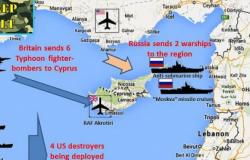Whatever happened to Peace? Arms, Oil and War by Proxy

We're living in a new era of proxy warfare, where multiple powers fund local proxies with disastrous consequences. We need to break the cycle.
The end of the Cold War was one of the few historical moments in which people around the world looked forward to a future that promised to be more just and peaceful for everyone. The Berlin Wall was finally torn down, following years of tireless civil society activism in one of the world’s few peaceful revolutions. Liberal democratic systems seemed to be spreading everywhere, compelling Francis Fukuyama to craft the (nowadays often-scorned) argument that “The End of History” – and consequently the cessation of constant conflict – had finally arrived with the falling of the Iron Curtain.
The promising world 'peace dividend', a term initially coined by US president George H.W. Bush and UK prime minister Margaret Thatcher, was on everyone’s lips. Hope was in the air. The Soviet Union and United States vowed to work together to further cut down on a nuclear arsenal that could have blown up the world many times over. And they also seemed to be hard at work getting rid of another major – and often underestimated – impediment to peace: proxy wars, the type of war waged in the developing world for most of the Cold War, from Latin America to Central Asia to the Horn of Africa. These were wars in which the Soviet Union and US did not directly fight, but paid and favored local fighters, often through highly classified operations and byzantine financial networks that have inspired generations of spy novelists. Before the Cold War, colonial regimes paid local proxies to advance their agendas and “divide and conquer”.
As the Cold War finally came to a close, it was hoped and anticipated that weapon donations would be replaced by UN Peacekeepers and a new generation of NGO activists. Indeed, the new crop of peacemakers seemed to be more liberated. Free from the stifling imperatives of geopolitics, they could implement deals that had previously died prematurely at the conference tables of diplomats, anxious over the advances of an enemy superpower. The tit-for-tat strategies that would reap destruction seemed to be a thing of yesteryear.
The “War to End all Wars” is a coinage that stems from the First World War. In the global public imagination: the Cold War would be the real “War to End all Wars.” Following its conclusion, an era of enduring peace was within immediate reach. Or so it seemed.
A new era of proxy wars
Fast forward 28 years since the fall of the Berlin Wall, and few such promised realities seem to have materialized. On the contrary, we have entered a new era of proxy wars.
Syria
According to some commentators, the conflict in Syria at the doorstep of Europe is a heart-wrenching case-in-point for a new type of intractable Middle Eastern proxy war in which not two, but multiple regional and global powers have become drawn into conflict. This is a conflict which finds its roots in an uprising against the dictatorial regime of president Assad, whose government, according to media accounts and studies, has committed unspeakable crimes against humanity, such as the use of barrel bombs, chemical weapon attacks and forced starvation campaigns. Between 312,001 and 470,000 Syrians have died with millions displaced.
In analyzing the Syrian conflict, we should, of course, not lift the moral onus off the Assad regime, nor create wrong moral equivalenies, as Syrian commentators such as Alia Malek, Sami Alkayial and Yasser Munif have warned. Sadly the Syrian conflict has become, to quote Mehdi Hasan, “the ultimate political and sectarian Rorschach test of our time.” Similarly, as Alia Malek points out:
“[A] lot of people are kind of placing Syria as a character, as a bit character, into their larger sort of geopolitical narratives of what is happening in this world. Whether you’re objecting to intervention by outside powers, you know, Syria just becomes like the latest theater to have that discussion. Whether it’s a discussion about sectarianism and whether Sunnis are being killed by Shia, it just becomes […] a way to look at Syria in that sense. But I’m—I’ve always advocated for looking at Syria for the sake of Syrians and creating a country that is stable and safe and free for all its people.”
Such cautionary words notwithstanding, the internationalization of the Syrian conflict has made it more intractable. Though the Syrian conflict has been described as a proxy conflict between the US and Russia, the most prominent of the powers contending for influence in Syria are regional. Part of the reason for this support is that Iran, Shiite sectarian arch-enemy of the Gulf monarchies, supports the Syrian government as well as local Hezbollah and even Iranian fighters who entered Syrian territory. Because of the Sunni Iranian involvement, Saudi Arabia, Qatar and other Arab Emirate countries have provided financial support to some of the supposedly moderate groups—the ones also vetted and backed by the US—, and allegedly also to some of the more radical groups. Qatar is accused of supporting the radical Al Nusra Front, which is considered an offspring of Al Qaida. EU countries and the United States support Kurdish fighters, while they are militarily opposed by Turkey, reportedly allowing DAESH fighters entry into the territory of neighboring Syria to maintain a counterbalance to Assad.
Yemen
The outbreak of intractable proxy wars is a problem that is not confined to Syria. Not too far away and in the same region, the country of Yemen has been engulfed in a proxy war involving Saudi Arabia, Iran, and the US. It’s a war that has often escaped public attention and media scrutiny, despite the attempts of NGOs such as Oxfam to bring the suffering of Yemeni civilians to the attention of western publics. According to UN estimates from August 2016, at least 10,000 have been killed or wounded in the conflict. According to experts, containing Iranian influences within the region also played a role in the Saudi decision to go to war in Yemen. In so doing, the Saudi military has received many of its weapons, including cluster bombs, from the US and EU countries, along with concrete tactical support from US military personnel.
Somalia
Across the Gulf of Aden, where Yemen is located, the failed state of Somalia is recovering from a proxy war of the post 9/11-era. Following the attacks of 9/11, the Bush administration decided that it would be necessary to oust the Islamic Courts that had created some stability in a country historically beset by conflicts. These conflicts had both a local and international dimension, especially in the 1980s when Somalia served as the theater for a Cold War proxy conflict. With US backing, Ethiopia invaded Somalia in 2006, leaving behind a trail of human rights abuses.
While the conflicts in Yemen, Somalia, and Syria are more readily identifiable proxy wars, even the supposedly classical military operations of the post 9/11-era had elements of proxy wars. After all, it wasn’t Russian military forces alone that annexed East Crimea. Russia’s 'little green men' (military personnel, unmarked) entered the area, formed local militias, pushed a pro-Russian agenda, then called for a vote on annexation.
The same goes for western invasions. It wasn’t the international ISAF Forces that singlehandedly defeated the Taliban in late 2001, but the US-backed Northern Alliance, initially made up of Tajik fighters. Though precise accounts of the fall of the Libyan state diverge, according to many credible narratives it was not a NATO airstrike but rebels supported by NATO airpower that executed Colonel Gaddafi on the streets of Misrata in March of 2012. Even before the invasion, the United Arab Emirates and Qatar competed for influence by arming different militias in a country that has long been a chessboard of global and regional politics. According to an analysis by Frederic Wehrey in the Washington Post, similar dynamics still plague the country. In the case of the Iraq invasion, which had initially been fought without indigenous proxies, US planners attempted to recruit local conscripts to bring stability following the post-invasion chaos. The so-called “Anbar Awakening”, vigilantes cooperating with US forces, quenched some of the post-war violence and facilitated the eventual troop withdrawal from Iraq, though both were only temporary.
Regime change
Recent western military invasions may not have been proxy wars in the classical Cold War sense: that is, competitions between two proxies for greater powers fighting in the same territory. Instead, proxy forces were relied on to topple regimes. An early definition of proxy wars, formulated by Karl Deutsch, considered them “an international conflict between two foreign powers, fought out on the soil of a third country.” A more recent one by Andrew Mumford considers proxy wars “conflicts in which a third party intervenes indirectly in order to influence the strategic outcome in favor of its preferred faction.” Following this newer definition, the more recent regime change operations as well as the annexation of East Crimea, and the long and tragic ripple effects that would cost the lives of hundreds of thousands if not more, could be considered proxy wars.
The causes of proxy wars
To bring these complex wars to a halt, we have to be very precise about what keeps them going. Saudi Arabia and Iran, probably the two main players in proxy wars in a destabilizaion of the Middle Eastern region that is steadily increasing, fund proxy forces to bolster their versions of Islam—Sunni and Shiite Islam, respectively. It is safe to assume that from the perspective of Riyadh and Teheran, furthering sectarian interests, inextricably intertwined with access to resources and geopolitical influence, are of more importance than peace in the region.
But it is not only sectarian strife—often highlighted in the western media—but also global unregulated capitalism that pours kerosene on a Middle East that is already in flames.
Western weapon companies see the newly emerging proxy wars as momentous opportunities for increased revenues. During a 2015 conference of Lockheed Martin in Palm Beach Florida, its executive vice president Bruce Tanner predicted “indirect benefits” from the war in Syria. Similarly, as the Intercept reports, Raytheon chief executive Tom Kennedy spoke of “a significant uptick” for “defense solutions across the board in multiple countries in the Middle East.” Referring to Saudi Arabia, Kennedy elaborates, “It’s all the turmoil they have going on, whether the turmoil is occurring in Yemen, whether it’s with the Houthis, whether it’s occurring in Syria or Iraq, with ISIS.” And sure enough, stocks for arms have soared in recent years.
But it is not only weapons but also oil which disincentivizes policy makers from de-escalating proxy wars. As Christopher Davidson, who the Economist called “one of the most knowledgeable academics” writing about the Middle East, shows in his 688-page long tome “Shadow Wars: The Secret Struggle for the Middle East,” how many covert operations in the Middle East were historically supported to advance the explicit geopolitical or economic interests of the funders. According to Davidson, the emergence of the US as a major oil producer has motivated US policy makers to let Saudi forces engage in exhausting proxy wars throughout the region so that a weakened Saudi Arabia is forced to sell its state assets.
Whatever the precise motivations, aside from the publicly touted humanitarian rationales, oil and weapons play a role in the decisions made by states, even when lives are at stake.
But whatever the argument, the evidence in support of proxy wars as an effective means in the interest of peace is scarce. At least this is the case if one follows the analysis coming from the proverbial mouth of the horse, the CIA. The spy agency has funded proxy fighters for most of its history. Reportedly president Obama, at least an initial skeptic in the use of proxies, was interested in finding out if funding insurgents generally accomplish the stated strategic goals and commissioned an internal study.
The report concluded that conflicts were not decided in the interest of the US following the funding of proxy actors, unless, according to the report, US personnel were on the ground along with the proxies. The notable exception—according to the study—was the support for the Mujahidin against the Soviet Union in the 1980s. However, although the Mujahidin did ultimately chase the illegally invading Soviet forces out of the country, Afghanistan did not regain stability. One thing to come out of this instability was the merging of the Mujahidin into Al Qaida: the very same enemy the US fights in the current global 'War on Terror'. This is not just one war, but multiple new proxy wars that cause immense suffering and which have, according to the Global Terrorism Index, contributed to an almost nine-fold increase in deaths caused by terrorism between 2000 and 2016. If we consider the entire historical context, the Afghanistan example serves, at best, as a very cautionary tale.
What happened the last time proxy wars ended?
Faced with a history of such tragic blowbacks, it seems self-evident that we had better seriously contemplate workable alternatives. What can we do instead of embarking on a perilous path towards funding more and more local fighters? Was there ever a time in which we collectively escaped the fatal trap of the proxy war? Has it been done before? How can we influence states and corporations so that they work towards disentangling proxy wars?
As it turns out, we must go back to the aforementioned moment in history in which world leaders at least tried giving peace a chance on a global scale: the end of the Cold War. The conventional wisdom is that global efforts to curb violence following the Cold War have fallen flat, that out of the ruins of the battlefields of the proxy wars in the Global South and the Soviet Empire in Eastern Europe and Central Asia, ethnically motivated violence, no longer encumbered by Cold War authoritarian regimes, caused havoc. But has the post-Cold War landscape really been so bleak? Are ethnically motivated clashes and indigenous warfare the inevitable replacement of proxy wars?
One could say that the end of the Cold War is a historic test case for whether proxy wars can be stopped. As it turns out, the Human Security Report conducted by the Simon Frasier University in Canada, the most rigorous investigation of what happened in regards to global conflicts following the Cold War, gives some reason to hope.
The research, which annually measures the numbers of incidences of violence such as internal and international wars, reports that there was “a dramatic, but largely unknown, decline in the number of wars, genocides, and human rights abuse" over the roughly fifteen years following the end of the Cold War.
At the time one of their major reports was commissioned in 2005, the number of armed conflicts around the world had reduced by 40 percent. The report sees the end of proxy wars as a major cause for the reduction of violence. Without external assistance, conflicts, in the words of the investigators, “simply petered out, or were ended by negotiated settlements.” Conflicts such as those in Angola did drag on for a bit following the Cold War, but in the absence of international support for proxies they became resolved within the fifteen years following it. What took the place of external military assistance was a proliferation of international activism to stop wars, prevent the outbreak of wars that had been ended, and aid in the post-conflict reconstruction following the signature of peace settlements. Contrary to common perceptions, the peace dividend paid off.
Towards a new peace dividend and movement
Though the most recent Human Security Report, dating from 2013, reported a further decline in conflicts, one of the more recent rigorous projects to globally measure the prevalence of conflicts, the Uppsala Conflict Data Program (UCDP), demonstrates that 2014 saw an increase in the number of active conflicts and also the casualties from battle. Forty armed conflicts were active in 2014, whereas in 2013 34 conflicts were designated active. The increase in conflicts since 1999 stood at 18 percent. Whatever gains were brought about by the 'peace dividend', they have been reversed, with people all over the world paying the greatest price.
Following the Cold War, the willingness to invest some of the political energy otherwise put into warfare reduced the number of conflicts. Not enough, of course. Counting the worldwide number of deaths gives no comfort to those who have lost loved ones in conflict. But what the study by Simon Frasier University shows is that global political will for more peaceful solutions can indeed translate into tangibly less conflict on the ground.
This political will is, unfortunately, in very short supply in this day and age. Recently Mikhail Gorbachev, a major architect of the policies that facilitated the end of the Cold War and perhaps one of the most daring and innovative agents for peace in the twentieth century, wrote an op-ed in the Times, entitled “It All Looks as if the World Is Preparing for War”, in which he sums up the current historical moment by stating,
“The world today is overwhelmed with problems. Policy makers seem to be confused and at a loss. But no problem is more urgent today than the militarization of politics and the new arms race. Stopping and reversing this ruinous race must be our top priority.”
There seems to be no regret among decision makers in Moscow about having armed rebels in East Ukraine, or about its current support for the slaughter in Syria. There is also little support for a bolder, more peaceful foreign policy in the US. From Somalia to Yemen, US politicians have accepted “counterinsurgency warfare”, which includes arming local forces, as a less politically costly and militarily effective alternative to ground force invasions. This shift in strategy was arguably stronger, not weaker, for much of the presidency of Obama, a politician who was not only ushered into office with a public mandate to create a more peaceful foreign policy, but also received a Nobel Peace Prize to bolster his plans shortly following his inauguration.
President Donald Trump, by contrast, initially critical of Hillary Clinton’s foreign policy, has stepped up military activities since he took office. For example, drone strikes, an important component in the theatre of war in Yemen, have gone up by 432 percent.
In contrast to Trump and Clinton, the Bernie Sanders campaign had a more authentic political platform when it came to the issue of de-escalating conflicts. In the debate with Hillary Clinton, he cited historical examples to make a strong and coherent argument against escalating conflicts.
A new type of vigorous and principled peace movement must be formed in this time of crisis. Peace movements in rich countries should join Middle Eastern peace movements that rally for more democratic and less sectarian governance. Social movements can become stronger by integrating divergent points of view, histories and ideologies, which inform interpretations of complex conflicts. It necessarily has to look at the various internal roots of conflict, and also at how foreign governments, from Moscow and Washington to Riyadh and Teheran, fuel conflicts.
Supporting and holding political platforms accountable will be key to demilitarizing political ideologies and stopping the world in its “ruinous race” to global war, to use the words of Gorbachev. More often than not, a call to arm a party to a conflict prolongs said conflict.
The public’s immediate question with regards to conflicts probably shouldn’t be “Whom should we support militarily?” Instead, we should more seriously consider questions such as “Who keeps a conflict going?” and “How can we de-escalate it?”
As profits soar while countries spiral into chaos, a new peace movement cannot compel states to act more responsibly or to de-escalate conflict without challenging a global economic system that puts profits over people. If we fail to do so, the next 'peace dividend' will again be short-lived. Governments cannot serve as effective diplomats if their representatives indirectly represent the interests of the defense or oil industries. Just as reducing the grip of sectarianism on conflict resolutions has to be accomplished in the Middle East, it is up to us westerners to bring global war profiteering out of the shadows of impunity. For such political activism to happen, we have to realize that the out-of-control weaponization of regional conflicts is one of the twenty-first century’s many major challenges.
Somehow we the people—who, against all odds, want to raise our children in a more peaceful world—have to let our politicians know that arms should be removed from most regions of conflict.
Far from being out of touch with reality, the global peace movement—though worryingly weakened—in fact holds the most realistic solutions to conflict. Given the data, it is clear that negotiation with the actors in a conflict is the best route to peace. De-escalation is the only framework in tune with the realities of the contemporary world as well as the lessons of recent history. We have to compel regional and global forces to work towards de-escalating conflicts. Challenging the financial incentives that bring weapons into the hand of proxies may be one of the most effective ways to do so.
Jonas Ecke currently serves as the Advisor for Refugee Integration at the University of Potsdam, having researched cultural change among refugees in West Africa at Purdue University. Jonas now also conducts research for various NGOs, committed to improving policy, but also to intensifying efforts at addressing the roots of the conflicts that cause displacement. This post first appeared on OpenDemocracy.
Photo credit: Facts for a Better Future via Foter.com / CC BY-SA


